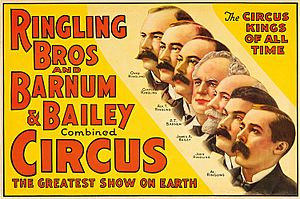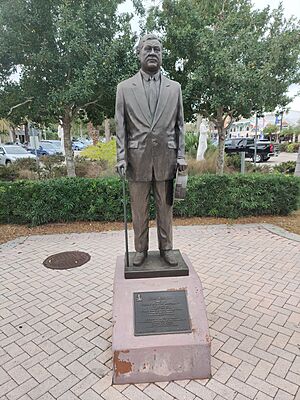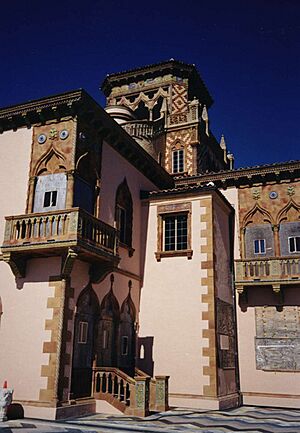John Ringling facts for kids
Quick facts for kids
John Ringling
|
|
|---|---|

Ringling, c. late 19th century
|
|
| Born |
Johan Nicholas Rüngeling
May 31, 1866 McGregor, Iowa, U.S.
|
| Died | December 2, 1936 (aged 70) New York City, New York, U.S.
|
| Resting place | John and Mable Ringling Museum of Art |
| Known for | |
| Spouse(s) |
Mable Burton
(m. 1905; Emily Haag Buck
(m. 1930; div. 1936) |
| Parents |
|
| Relatives |
|
John Nicholas Ringling (born May 31, 1866 – died December 2, 1936) was a very successful American businessman. He is the most famous of the seven Ringling brothers. Five of the brothers combined their own Ringling Bros. World's Greatest Shows with the Barnum & Bailey Circus. This created a huge circus company that became a major part of modern circus history.
Besides owning and running many of America's biggest circuses, John Ringling was also a rancher, a real estate developer, and an art collector. He was recognized for his contributions and was added to the Florida Artists Hall of Fame in 1987.
Contents
Starting a Circus Life
John was born in McGregor, Iowa. He was the fifth son in a family of seven sons and one daughter. His mother, Marie Salomé Juliar, was French, and his father, August Ringling, was German. The family's original name was "Ruengeling." Five of the brothers worked together to build a huge circus business.
The Ringling brothers started their first show in 1870. It was called "The Ringling Bros. United Monster Shows, Great Double Circus, Royal European Menagerie, Museum, Caravan, and Congress of Trained Animals." They charged only one penny to get in! By 1882, their show was known as "The Ringling Bros. Classic and Comic Concert Company."
By 1889, the circus had grown so much that it could travel by train cars. Before this, they had to use animal-drawn wagons. This was a big step for their growing business.
In 1905, John married Mable Burton. Two years later, in 1907, the brothers bought the Barnum & Bailey circus. They paid $400,000 for it from the family of James Anthony Bailey. For a while, they ran the two circuses separately. John worked closely with his brothers, saying, "We divided the work; but stood together." John was in charge of traveling ahead to book shows, while Charles managed the daily operations.
Building a Circus Empire
After buying Barnum & Bailey's Greatest Show on Earth in 1907, the Ringling brothers became known as the "Circus Kings" in the United States. They controlled not only their own show but also the Barnum & Bailey circus. They also owned the Adam Forepaugh and Sells Brothers Circus.
In the early 1900s, the Ringling brothers' family started to get smaller. Otto died in 1911, followed by Albert in 1915, and Henry in 1918. At the same time, it was hard for the Ringlings to keep two huge circuses touring during World War I. There weren't enough workers, and there were rules about using railroads. Also, the 1918 flu pandemic made things difficult.
Because of these challenges, the brothers decided to combine their two big circuses. So, at the end of the 1918 season, the Ringling Bros World's Greatest Shows and the Barnum & Bailey Greatest Show on Earth became one giant show. On March 29, 1919, the new Ringling Bros. and Barnum & Bailey Circus had its first show at Madison Square Garden in New York City.
After Alfred T. Ringling died in 1919, John and Charles decided to move the circus's winter home to Sarasota, Florida, in 1927. The brothers had been successful buying and selling land there. Sadly, Charles died in 1926 before the move was finished. With Charles's death, John was the last of the Ringling brothers still alive. Even though other family members owned parts of the company, John continued to manage the circus as its President.
During the 1920s, Ringling built a large 20-room house called Gray Crag. This was their summer home in Alpine, New Jersey. It sat on top of the New Jersey Palisades and looked out over the Hudson River. John would sometimes bring circus performers and animals across the river from Yonkers, New York, to entertain guests at parties. However, during the Great Depression, John faced many money problems. He lost control of the property, and the house was torn down in 1935.
In 1909, John and his wife, Mable, started spending their winters in Sarasota. They bought land by the bay from another circus manager. Ringling asked a New York architect to design a 30-room mansion for them. It was inspired by the beautiful palaces in Venice, Italy. The house was finished in 1926 and named Cà d'Zan, which means "The House of John" in the Venetian language.
Later, a museum was built on the estate to hold their amazing art collection. Because of their land investments and the circus's winter home becoming a tourist spot, John and his brother Charles are seen as important people in Sarasota's growth. After about 40 years in the entertainment business, and owning railroads, oil fields, and ranches, John became one of the richest men in the world. He also traveled a lot, always looking for new acts for his circus. During his trips to Europe, he started collecting old masterpieces and Baroque art, including paintings by the famous artist Peter Paul Rubens.
In 1929, John Ringling bought the American Circus Corporation. This company owned several other circuses, including the Sells-Floto Circus, the Hagenbeck-Wallace Circus, and Buffalo Bill's Wild West Show. He bought them for $1.7 million. With this purchase, Ringling owned almost all the major traveling circuses in America.
In 1933, John Ringling, who was sick and getting old, had to go to court. He had once owned more circuses than anyone else and was worth about $50,000,000. But a loan had caused him big problems. He had borrowed $1,700,000 and used half of his circus stocks as a guarantee. When he couldn't make an interest payment of about $18,000, he lost control of most of his assets. He was left with almost nothing, but he was one of the trustees, meaning he could get his assets back if he paid off the loan.
Other Businesses and Interests
John Ringling was involved in many different businesses. These included railroads in several states, oil in Oklahoma, and real estate in Florida.
- He was a director and shareholder at the Chatham and Phenix National Bank of New York.
- He was president of the John Ringling Real Estate Company in Sarasota.
- He was vice-president and chairman of the board for the Madison Square Garden Corporation.
- He was president of the Madison Square Garden Sporting Company.
- He was president and financier of the Oklahoma, New Mexico and Pacific Railway, also known as the Ringling Railroad.
- He was also president of the White Sulphur Springs and Yellowstone Park Railway.
Places Named After John Ringling
- Ringling, Montana, was named after John Ringling. He was once president of the White Sulphur Springs and Yellowstone Park Railway. John Ringling had a summer home in White Sulphur Springs and wanted to build a big resort there.
- Ringling, Oklahoma, was also named for Ringling when his railway created the town.
- A World War II ship, the SS John Ringling, was named in his honor.
- The John Ringling Causeway is a bridge in Sarasota, Florida. It connects Sarasota to Lido Key and Longboat Key. Ringling lived in Sarasota for many years and built the first bridge there in 1925.
Later Life and Death
John Ringling's health began to get worse. The Great Depression, which started soon after he bought the American Circus Corporation, caused huge financial problems for him. He lost almost all his money, but he was able to keep his home, the museum, and his large art collection.
His wife, Mable, died in June 1929. He remarried on June 19, 1930, to Emily Haag Buck in Jersey City, New Jersey. However, John and Emily Haag Buck divorced on July 6, 1936.
In 1932, the circus's board of directors voted John out of control of the business. Sam Gumpertz was then named vice president and general manager of the circus.
John Ringling died on December 2, 1936, in New York City. He was the last of the Ringling brothers to pass away, and he lived the longest, reaching his 70s. Even though he was once one of the richest men in the world, he died with only $311 in his bank account.
When he died, he left his Sarasota mansion, the museum, and his entire art collection to the state of Florida. His house, Cà d'Zan, and the John and Mable Ringling Museum of Art let visitors see what life was like in the Roaring 20s. They also offer a famous art collection and library. Another important part of John's legacy is the Ringling College of Art and Design. This school asked to use his name because of the museum's cultural importance. A museum about the Ringling Brothers Circus has also been built on the estate.
After John's death, his nephew, John Ringling North, ran the circus. He later sold the circus in 1967.
In 1991, John and Mable Ringling, along with his sister, Ida Ringling North, were reburied at the John and Mable Ringling Museum of Art. Their graves are in a special place called the secret garden, with John buried between the two women.
The Ringling Bros. and Barnum & Bailey Circus eventually closed after 146 years. Due to fewer people attending, protests about animal rights, and high costs, it had its final show on May 21, 2017.
The Ringling Family
There were seven Ringling brothers and one sister, Ida. Four of the brothers (Alf, Al, Charles, and Otto) worked with John to create the famous Ringling Bros. circus:
- Albert Charles "Al" Ringling (1852–1916)
- Augustus Gustav "Gus" Ringling, Jr. (1854–1907)
- William Henry Otto "Otto" Ringling (1858–1911)
- Alfred Theodore "Alf T." Ringling (1861–1919)
- Charles Edward "Charley" Ringling (1863–1926)
- John Nicholas Ringling (1866–1936)
- Henry William George Ringling (1868–1918)
- Ida Loraina Wilhelmina Ringling (1874–1950)





